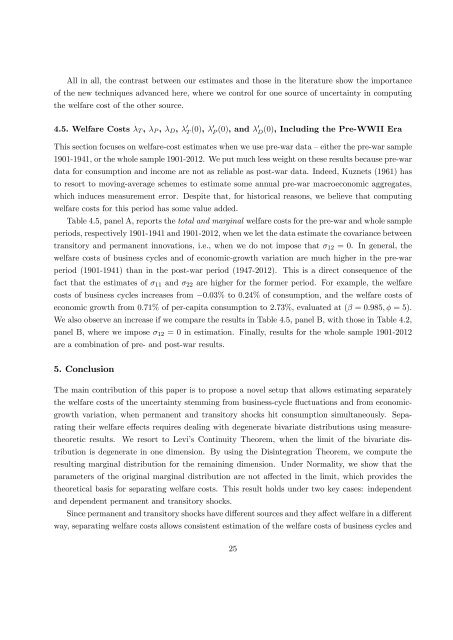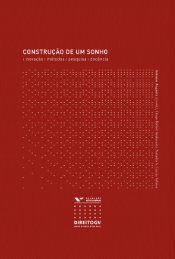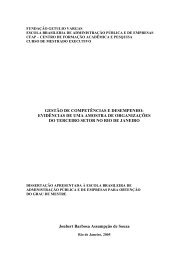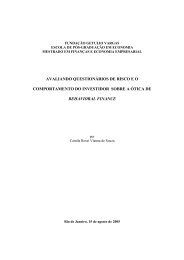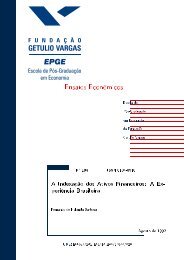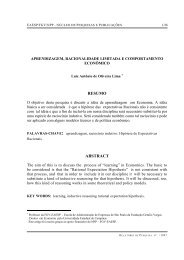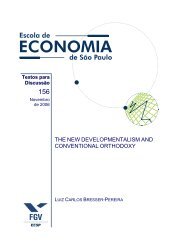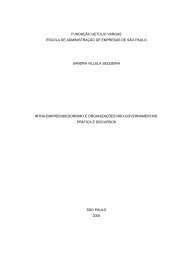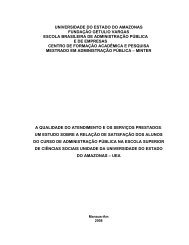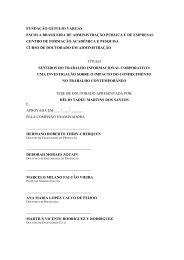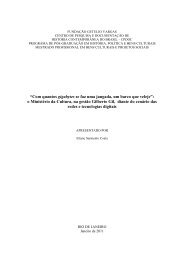Ensaios Econômicos - Sistema de Bibliotecas da FGV - Fundação ...
Ensaios Econômicos - Sistema de Bibliotecas da FGV - Fundação ...
Ensaios Econômicos - Sistema de Bibliotecas da FGV - Fundação ...
Create successful ePaper yourself
Turn your PDF publications into a flip-book with our unique Google optimized e-Paper software.
All in all, the contrast between our estimates and those in the literature show the importance<br />
of the new techniques advanced here, where we control for one source of uncertainty in computing<br />
the welfare cost of the other source.<br />
4.5. Welfare Costs T , P , D , 0 T (0), 0 P (0), and 0 D<br />
(0), Including the Pre-WWII Era<br />
This section focuses on welfare-cost estimates when we use pre-war <strong>da</strong>ta –either the pre-war sample<br />
1901-1941, or the whole sample 1901-2012. We put much less weight on these results because pre-war<br />
<strong>da</strong>ta for consumption and income are not as reliable as post-war <strong>da</strong>ta. In<strong>de</strong>ed, Kuznets (1961) has<br />
to resort to moving-average schemes to estimate some annual pre-war macroeconomic aggregates,<br />
which induces measurement error. Despite that, for historical reasons, we believe that computing<br />
welfare costs for this period has some value ad<strong>de</strong>d.<br />
Table 4.5, panel A, reports the total and marginal welfare costs for the pre-war and whole sample<br />
periods, respectively 1901-1941 and 1901-2012, when we let the <strong>da</strong>ta estimate the covariance between<br />
transitory and permanent innovations, i.e., when we do not impose that 12 = 0. In general, the<br />
welfare costs of business cycles and of economic-growth variation are much higher in the pre-war<br />
period (1901-1941) than in the post-war period (1947-2012). This is a direct consequence of the<br />
fact that the estimates of 11 and 22 are higher for the former period. For example, the welfare<br />
costs of business cycles increases from<br />
0:03% to 0:24% of consumption, and the welfare costs of<br />
economic growth from 0:71% of per-capita consumption to 2:73%, evaluated at ( = 0:985; = 5).<br />
We also observe an increase if we compare the results in Table 4.5, panel B, with those in Table 4.2,<br />
panel B, where we impose 12 = 0 in estimation. Finally, results for the whole sample 1901-2012<br />
are a combination of pre- and post-war results.<br />
5. Conclusion<br />
The main contribution of this paper is to propose a novel setup that allows estimating separately<br />
the welfare costs of the uncertainty stemming from business-cycle ‡uctuations and from economicgrowth<br />
variation, when permanent and transitory shocks hit consumption simultaneously. Separating<br />
their welfare e¤ects requires <strong>de</strong>aling with <strong>de</strong>generate bivariate distributions using measuretheoretic<br />
results. We resort to Levi’s Continuity Theorem, when the limit of the bivariate distribution<br />
is <strong>de</strong>generate in one dimension. By using the Disintegration Theorem, we compute the<br />
resulting marginal distribution for the remaining dimension. Un<strong>de</strong>r Normality, we show that the<br />
parameters of the original marginal distribution are not a¤ected in the limit, which provi<strong>de</strong>s the<br />
theoretical basis for separating welfare costs. This result holds un<strong>de</strong>r two key cases: in<strong>de</strong>pen<strong>de</strong>nt<br />
and <strong>de</strong>pen<strong>de</strong>nt permanent and transitory shocks.<br />
Since permanent and transitory shocks have di¤erent sources and they a¤ect welfare in a di¤erent<br />
way, separating welfare costs allows consistent estimation of the welfare costs of business cycles and<br />
25


